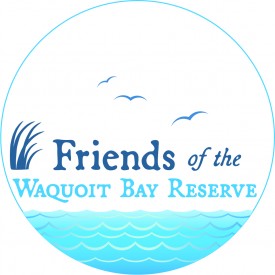Developing a method to survey blue crabs on oyster farms in southern Cape Cod
Project Title: Developing a method to survey blue crabs on oyster farms in southern Cape Cod
Duration: June 2025-December 2025
Funding Source(s): Internal funding from Wellesley College
Principal Investigator: Becca Selden, Wellesley College
Contact: rs5@wellesley.edu
Project Description: As blue crabs are moving poleward with warming waters, they are increasing in abundance at their historic range edge in southern Cape Cod and increasingly being found further north in the Gulf of Maine. Oyster farmers are frequent observers of blue crabs and green crabs in and around their gear. We are interested in developing a survey that could be deployed at oyster farms throughout the region as a sentinel of the blue crab range expansion. We have partnered with oyster farms in Waquoit Bay, Cotuit Bay, and Barnstable to identify protocols for surveying different types of oyster gear and to identify emergent patterns on crab spatial distributions as a function of season and linked to environmental variables collected at nearby water quality sampling stations. In WBNERR we are working with the town of Falmouth oyster farm within Waquoit Bay. We will record the number, size, and sex of crabs on or in their array of floating gear, and relate that to gear design and mesh size. The pilot project will begin in Summer 2025 and sampling will occur monthly throughout the summer and fall of 2025.
The impact of excess nutrients on Waquoit Bay estuarine biota
Project Title: The impact of excess nutrients on Waquoit Bay estuarine biota
Duration: May-2023 to December-2023
Funding Source(s): Various educational programs at MBL, including the Logan Science Journalism Program, the NSF-REU Biological Discovery in Woods Hole Program, the University of Chicago Metcalf Summer Internship Program, the Brown-MBL LINK Internship Program, and the Semester in Environmental Science.
Lead Investigators: Mirta Teichberg
Onsite-contact: Kelsey Chenoweth
Affiliation: Marine Biological Laboratory
Email: kchenoweth@mbl.edu
Project Description: Teichberg, with several groups of students, fellows, and faculty from several educational programs at the Marine Biological Laboratory, will be developing projects aimed at understanding the effects of excess nutrient loadings on ground- and estuarine water quality, and their impacts on the food webs of the various Waquoit Bay estuaries. They will define links between nitrogen loads from shifting land use and atmospheric deposition for the region, groundwater nitrogen concentrations, and water quality indicators in selected receiving estuaries. To achieve this goal, they will evaluate how changing climate drivers (increased rainfall, lowered nitrogen concentrations in deposition, and higher temperatures) alter timing and amount of nitrogen discharged from watersheds to receiving estuaries. They will also examine how excessive nitrogen loads alter the composition and structure of estuarine food webs. Waquoit Bay’s range in nitrogen loads will serve as a wider context within which to place data from other local estuaries.
Effect of Sea Level Rise-Driven Vegetation Shifts and Die-Off on GHG Fluxes
Project Title: Effect of Sea Level Rise-Driven Vegetation Shifts and Die-Off on GHG Fluxes
Duration: 09/24-09/25
Funding Source: NOAA Margaret A. Davidson Fellowship
Lead Investigator: Emily Wilson, Boston University
Contact: wilson47@bu.edu
Project Description: Accelerated relative sea level rise (SLR) is threatening the survival of coastal salt marshes. While this is true nationally, salt marshes in New England are especially impacted because they have larger increases in SLR relative to the global average. As we lose salt marshes, we also lose the many ecosystem benefits they provide, including carbon storage. The objective of this study is to quantify how carbon dioxide and methane fluxes are indirectly impacted by SLR through shifts in marsh vegetation. Specifically, SLR is causing flood tolerant salt marsh species to take over the habitat of flooding sensitive species in the high marsh. In this study, carbon dioxide and methane fluxes will be measured across different elevation communities along an elevation gradient. Understanding the role of SLR on the carbon storage capacity of salt marshes is critical to better managing these dynamic systems and developing more accurate coastal GHG budgets.
Novel Probes for Real Time Monitoring of Dissolved Gases and their Isotopologues in Aquatic Systems
Project Title: Novel Probes for Real Time Monitoring of Dissolved Gases and their Isotopologues in Aquatic Systems
Duration: May 2025 – December 2026
Funding Source: NOAA-SBIR (NOAA-OAR-OAR-TPO-2022-2007117)
Lead Investigator: Scott Wankel, Woods Hole Oceanographic Institution (Marine Chemistry)
Contact: sdwankel@whoi.edu
Lead Investigator: Joanne Shorter, Aerodyne Research, 45 Manning Rd., Billerica MA 01821
Contact: shorter@aerodyne.com
Project Description: Dissolved gases are major signals of ecosystem processes that offer key insights into the health and function of aquatic systems including photosynthesis, respiration and nutrient cycling among many others. The goal of this project is to develop an underwater sampling probe that can be coupled to cutting-edge sensors for measuring concentrations and stable isotope composition of climatically active trace gases including methane and nitrous oxide. We will test a new field-based analysis system, evaluating a new probe design for an underwater inlet placed in the shallow waters of Waquoit Bay to monitor levels of methane and nitrous oxide in real time. Concentrations and isotopic composition measurements will be automatically made using a tunable diode laser absorption spectrometer (TDLAS). Understanding variations in the concentrations and isotopic composition of these gases will help inform how coastal systems like Waquoit Bay may serve as important sources or sinks of these important atmospheric trace gases. This project represents a collaboration between a small business (Aerodyne Research, Inc.) and a research institution (WHOI).
Efficacy of established and emerging tidal marsh restoration methods
Project Title: Efficacy of established and emerging tidal marsh restoration methods
Lead Investigator: Brian Yellen, UMass Amherst, byellen@umass.edu
Onsite Contact: Sintra Reves-Sohn, UMass Amherst, srevessohn@umass.edu
Project Description: Salt marshes are extremely beneficial to surrounding communities because they provide recreational spaces, control floods, and improve water quality. Salt marshes also effectively store carbon and are home to resident species, such as the endangered saltmarsh sparrow and commercially and culturally important fish stocks. Vegetation is key to salt marsh survival; when the marsh is flooded at high tide, salt marsh vegetation traps sand and mud, which makes it possible for the salt marsh to build upward. This is especially important for salt marsh survival when sea level is rising quickly. If the marsh can’t build elevation, it will be outrun by rising sea levels. In addition to the threat of sea level rise, the Dog’s Head Marsh at Waquoit Bay National Estuarine Research Reserve is vulnerable due to an undersized culvert that was removed in 2008. Pre-removal, the culvert prevented tides from traveling far upstream, causing the once salty ecosystem to “freshen,” which in turn causes the land to subside (become low in elevation). When the culvert was removed in 2008, saltwater flooded this upstream area, which caused the freshwater vegetation to die, and creating a muddy expanse. The aim of this project is to characterize how sediment is moving through Sage Lot Pond and into Dog’s Head Marsh at WBNERR and understand how this relates to how Dog’s Head Marsh’s vegetation has adapted post-culvert removal. With this information, we can better predict how Dog’s Head Marsh will continue to adapt to rising sea level and we can make recommendations to how to best preserve the salt marsh.
salty ecosystem to “freshen,” which in turn causes the land to subside (become low in elevation). When the culvert was removed in 2008, saltwater flooded this upstream area, which caused the freshwater vegetation to die, and creating a muddy expanse. The aim of this project is to characterize how sediment is moving through Sage Lot Pond and into Dog’s Head Marsh at WBNERR and understand how this relates to how Dog’s Head Marsh’s vegetation has adapted post-culvert removal. With this information, we can better predict how Dog’s Head Marsh will continue to adapt to rising sea level and we can make recommendations to how to best preserve the salt marsh.
Impacts of tidal hydrology on maritime forest and coastal marsh dieback
Project Title: Impacts of tidal hydrology on maritime forest and coastal marsh dieback
Duration: July 2023 – Dec 2023 (continuation of July 2020-present project)
Funding Source(s): NSF, Geological Society of America Student Grant
Principal Investigator: Elizabeth Watson, Stony Brook University (Elizabeth.b.watson@gmail.com )
Onsite Contact: Andrew Payne, Drexel University and the Academy of Natural Sciences (ap3752@drexel.edu)
Project Description: This project will analyze groundwater patterns, salinity, and plant stress using mapping of near-infrared spectral indices, and plant photosynthesis measures to address knowledge gaps in our understanding of the impacts of sea level rise to maritime forests and salt marsh. We are focusing on understanding the proximate causes of marsh forest dieback by building robust and complementary geospatial datasets focusing on key hydrologic factors and plant stress indicators. This project also involves study sites in New Jersey and New York.
Restoring hydrology using runnels and salt marsh N biogeochemistry
Project Title: Restoring hydrology using runnels and salt marsh N biogeochemistry
Duration: Aug 2022-Jul 2024
Funding Source(s): Margaret A. Davidson Graduate Fellowship, NOAA
Lead Investigator / onsite-contact: Linda Deegan, Jen Bowen, Meagan Tyrrell
Affiliation: Woodwell Climate Research Center; Northeastern University
Email: hsullivan@woodwellclimate.org
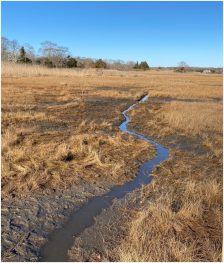 Project Description: Salt marshes are highly dynamic and variable systems providing many ecosystem services such as shoreline stabilization and nutrient filtration. However, because of their location within the tidal frame and proximity to human activity, they are vulnerable to a combination of anthropogenic and climatic disruptions. The objectives of this project are to understand the effects of altered hydrology via sea-level rise on the vulnerability of salt marsh productivity and N removal, and if restoration can enhance the resiliency to future changes. We will implement a relatively new restoration strategy called runnels, which are shallow channels designed to help drain standing water off the marsh surface and encourage vegetation. This project will examine unintended consequences of such restoration strategies on N cycling.
Project Description: Salt marshes are highly dynamic and variable systems providing many ecosystem services such as shoreline stabilization and nutrient filtration. However, because of their location within the tidal frame and proximity to human activity, they are vulnerable to a combination of anthropogenic and climatic disruptions. The objectives of this project are to understand the effects of altered hydrology via sea-level rise on the vulnerability of salt marsh productivity and N removal, and if restoration can enhance the resiliency to future changes. We will implement a relatively new restoration strategy called runnels, which are shallow channels designed to help drain standing water off the marsh surface and encourage vegetation. This project will examine unintended consequences of such restoration strategies on N cycling.
Impacts of tidal hydrology on maritime forest and coastal marsh dieback
Project Title: Impacts of tidal hydrology on maritime forest and coastal marsh dieback
Duration: July 2022 – Dec 2022 (continuation of July 2020-2021 project)
Funding Source(s): NSF, Geological Society of America Student Grant
Principal Investigator: Elizabeth Watson (Elizabeth.b.watson@gmail.com)
Onsite Contact: Andrew Payne (ap3752@drexel.edu)
Affiliation: Drexel University and the Academy of Natural Sciences
Project Description: This project will analyze groundwater patterns, salinity, and plant stress using mapping of near-infrared spectral indices, and plant photosynthesis measures to address knowledge gaps in our understanding of the impacts of sea level rise to maritime forests and salt marsh. We are focusing on understanding the proximate causes of marsh forest dieback by building robust and complementary geospatial datasets focusing on key hydrologic factors and plant stress indicators. This project also involves study sites in New Jersey and New York.
Pilot Drone Mapping of Marsh Biomass and Species for estimating Vegetation Drag
Title: Pilot Drone Mapping of Marsh Biomass and Species for estimating Vegetation Drag
Lead Investigator / onsite-contact: Heidi Nepf
Affiliation: Civil and Environmental Engineering, Massachusetts Institute of Technology
The flow resistance provided by coastal marshes mitigates flooding by slowing storm surge and damping waves. It also controls the flooding and draining of the marsh platform during the tidal cycle. The flow resistance (drag) provided by a marsh varies with seasonal growth, marsh erosion, and marsh area gained by restoration. It would be useful to have a method that directly measures marsh drag, which would improve the prediction of flooding and inform coastal planning, risk assessment, and restoration design. The Nepf lab has developed models that estimate drag on individual plants as a function of plant shape and rigidity, velocity and flow depth. In this project, we will develop a method to measure the number of plants per bed area and the species using drones to map biomass, plant height, and identifying geometric features. Combining measured plant density (plant per bed area) with predicted drag per plant will yield a measurement of flow resistance per marsh area. MASS DOT will fly the pilot drone mission to measure the spatial distribution of biomass, species, and plant height.
Transfer of a low-cost tidal wetland water level monitoring system: hyperlocal calculations of inundation and tidal datums for understanding change and restoration planning
Title: Transfer of a low-cost tidal wetland water level monitoring system: hyperlocal calculations of inundation and tidal datums for understanding change and restoration planning
Affiliation: Okeanolog/WBNERR
Funding Source: NERRS Science Collaborative Science Transfer gran
Contact/Email: Megan Tyrrell, Research Coordinator, WBNERR (megan.tyrrell@mass.gov)
Abstract: Waquoit Bay Reserve ongoing water level monitoring program focusing on discrete salt marsh microhabitats and employing a simple and inexpensive system of water level monitoring developed by PI Vitalii Sheremet. The ‘Arm-and-Float’ water level instrument uses a HOBO Pendant G accelerometer. These easy to deploy loggers have been used in several types of salt marsh habitats (e.g., pools, creeks and upstream of a tidal restriction) at WBNERR and other NERRs.
The principle of operation is based on converting the raw signal of the arm tilt into the elevation of the float relative to a fixed pivot by multiplication by the arm length. In this way, accuracy of 5-10 mm is achieved, which is adequate for calculating tidal datums for each feature where the logger is deployed. In May 2021, 20 arm-and-float loggers were deployed across Sage Lot Pond for water level monitoring in conjunction with seven other Reserves spanning a range of climactic and tidal regimes which also received arm-and-float loggers as part of the science transfer grant. At the conclusion of this project, locally relevant tidal datums will be calculated, and enhanced understanding of the differences in inundation regime for 20 salt marsh features including creeks, pools, nascent pools, surrounding potential tidal restrictions will be available.
A Fetch Dependent Gas Transfer Velocity
Project Title: A Fetch Dependent Gas Transfer Velocity
Year: 2020
Principal Investigators: Seth Zippel (AOPE) (szippel@whoi.edu) and Matthew Long (MCG)
Affiliations: Woods Hole Oceanographic Institution
Abstract: Air/water exchanges of gasses are important for both local biogeochemical cycles and for large scale climate change. Typically, these gas exchanges are parameterized as a function of wind speed without any direct consideration of the local turbulence or surface waves that are physically relevant to these transfers. As such, these parameterizations fail in coastal areas where waves are limited by fetch and modified by local currents and bathymetry. We propose a fetch-dependent gas transfer velocity based on existing theory for near surface turbulence and wave growth. We propose to test this new parameterization with local measurements in Waquoit Bay under a range of fetch and wind speeds. This parameterization will help the biogeochemical community estimate gas fluxes with simple inputs (locally measured wind speed and fetch from Google maps) without a need for measurements of complex turbulent dynamics. With increasing attention to the large role that coastal and estuarine environments play in global biogeochemical cycling, there is a growing consensus that better estimates of air/water exchange are needed to accurately describe their importance, as well as how this may be altered due to local anthropogenic influence and global climate change.
Water quality monitoring and modelling in Waquoit Bay estuaries
Project Title: Water quality monitoring and modelling in Waquoit Bay estuaries.
Date: 6/2019-11/2019
Principal Investigator(s): Ivan Valiela, Javier Lloret
Affiliations: Marine Biological Laboratory- The Ecosystems Center
Summary: The Valiela Lab, in addition to visiting students from the University of Chicago, Brown University, and the Semester in Environmental Science Program, will be developing projects aimed at understanding the relationship between watershed nitrogen loading and estuarine water quality in the Waquoit Bay estuaries. Building off of a series of recent project work undertaken in Waquoit Bay, we will continue to define links between N loads from shifting land use and atmospheric deposition for the region and water quality indicators in selected receiving estuaries. To achieve this goal, we will evaluate how changing climate drivers (increased rainfall, lowered nitrogen concentrations in deposition, and higher temperatures) alter timing and amount of N discharged from watersheds to receiving estuaries. Waquoit Bay’s range in N loads will serve as a wider context within which to place data from other local estuaries.
In addition, Javier will oversee the continuation of research begun during the SES 2018 semester on microplastics contamination in Waquoit Bay with a new cohort of students in 2019.
Greenhouse Gas Measurement at Sage Lot
Project Title: Greenhouse Gas Measurement at Sage Lot
Date: 5/2018-12/2018
Principal Investigator(s): Dr. Jim Tang, Dr. Faming Wang
Affiliations: MBL
Summary: In this study, we continued the field gas flux measurements at Sage lot salt marsh. We installed 4-inch diameter collars for soil respiration measurement, and big collar (20 inch) for the ecosystem level measurements. We installed warming chambers to heat the marsh to mimic the warming effect and measure the response of greenhouse gas fluxes to warming. The aim of this study is to measure CO2 and CH4 fluxes in the pristine salt marsh, and support our project to study New England Salt marsh blue carbon.
Coastal Soil Systems for a Changing Climate
Project Title: Coastal Soil Systems for a Changing Climate
Date: 9/2017
Principal Investigator(s): Mark Stolt and Amber Hardy
Affiliations: University of Rhode Island
Summary: Waquoit Bay sites were used in investigating the relationships between tidal marsh soils and their adjacent upland soils in the glaciated northeast, which will be important in the identification of marsh systems which are resilient to sea-level rise.
Ground Movement of a Salt Marsh due to Tidal Flooding and Draining
Project Title: Ground Movement of a Salt Marsh due to Tidal Flooding and Draining
Date: 1/2016-12/2019
Principal Investigator(s): Vitalii A. Sheremet
Affiliations:
Summary: While analyzing the water levels (at maximum tides) in pools and pannes developing at the Sage Lot Marsh due to the global sea level rise, we noticed discrepancies of up to 1 cm between some of the tide gauges (Sheremet and Mora, 2016: Precision Monitoring of Water Level in a Salt Marsh with Low Cost Tilt Loggers. In EGU General Assembly Conference) and hypothesized that they were caused by ground movement. We decided to instrumentally measure the swelling effect when the marsh is soaked up with water. We monitor water level and ground movement of the surface relative to deeper sandy levels and are developing a model that explains the soil properties, the relevant processes of marsh accumulation, and plant migration.
Genotype environment associations support a mosaic hybrid zone between two tidal marsh birds
Project Title: Genotype environment associations support a mosaic hybrid zone between two tidal marsh birds.
Date: 2016
Principal Investigators: Walsh, J., Rowe, R. J., Olsen, B. J., Shriver, W. G., & Kovach, A. I. (2016).
Summary: Ecology and Evolution, 6(1), 279-294. http://onlinelibrary.wiley.com/doi/10.1002/ece3.1864/full
Assessing tidal marsh resilience to sea-level rise at broad geographic scales with multi-metric indices
Project Title: Assessing tidal marsh resilience to sea-level rise at broad geographic scales with multi-metric indices
Date: 2016
Principal Investigator(s): Raposa, K. B., et al. (2016).
Affiliation: Kenneth B. Raposa (a), Kerstin Wasson (b), Erik Smith (c), Jeffrey A. Crooks (d), Patricia Delgado (e), Sarah H. Fernald (f), Matthew C. Fernerg (g), Alicia Helms (h), Lyndie A. Hice (i), Jordan W. Mora (j), Brandon Puckett (k), Denise Sanger (l), Suzanne Shull (m), Lindsay Spurrier (n), Rachel Stevens (o), Scott Lerberg (p)
a. Narragansett Bay National Estuarine Research Reserve, 55 South Reserve Dr., Prudence Island, RI 02872
b. Elkhorn Slough National Estuarine Research Reserve, 1700 Elkhorn Road, Watsonville, CA 95076
c. North Inlet-Winyah Bay National Estuarine Research Reserve, PO Box 1630, Georgetown, SC 29442
d. Tijuana River National Estuarine Research Reserve, 301 Caspian Way, Imperial Beach, CA 91932
e. Jug Bay Wetlands Sanctuary, 1361 Wrighton Road, Lothian, MD 20711
f. Hudson River National Estuarine Research Reserve, 256 Norrie Point Way, P.O. Box 315, Staatsburg, NY 12580
g. San Francisco Bay National Estuarine Research Reserve, 3152 Paradise Drive, Tiburon, CA 94920
h. South Slough National Estuarine Research Reserve, P.O. Box 5417, Charleston, OR 97420
i. Delaware National Estuarine Research Reserve, 818 Kitts Hummock Road, Dover, DE 19901
j. Waquoit Bay National Estuarine Research Reserve, 131 Waquoit Hwy, Woods Hole, MA 02536
k. North Carolina National Estuarine Research Reserve, 101 Pivers Island Rd., Beaufort, NC 28516
l. ACE Basin National Estuarine Research Reserve, 217 Fort Johnson Road, Charleston, SC 29412
m. Padilla Bay National Estuarine Research Reserve, 10441 Bayview-Edison Road, Mount Vernon, WA 98273
n. Grand Bay National Estuarine Research Reserve, Mississippi Department of Marine Resources, 6005 Bayou Heron Road, Moss Point, MS 39562
o. Great Bay National Estuarine Research Reserve, 89 Depot Rd, Greenland, NH 03840
p. Chesapeake Bay National Estuarine Research Reserve of Virginia at the Virginia Institute of Marine Sciences, 1375 Greate Road., Gloucester Point, VA 23062
Summary: Biological Conservation, 204, 263-275.
Tidal marshes and the ecosystem services they provide may be at risk from sea-level rise (SLR). Tidal marsh resilience to SLR can vary due to differences in local rates of SLR, geomorphology, sediment availability and other factors. Understanding differences in resilience is critical to inform coastal management and policy, but comparing resilience across marshes is hindered by a lack of simple, effective analysis tools. Read full text… http://www.sciencedirect.com/science/article/pii/S0006320716305742
Potential Effects of Sea-Level Rise on the Depth to Saturated Sediments of the Sagamore and Monomoy Flow Lenses on Cape Cod, Massachusetts
Project Title: Potential Effects of Sea-Level Rise on the Depth to Saturated Sediments of the Sagamore and Monomoy Flow Lenses on Cape Cod, Massachusetts
Date: 2016
Principal Investigator(s): Bay, C.C.
Publication: In 2014, the U.S. Geological Survey, in cooperation with the Association to Preserve Cape Cod, the Cape Cod Commission, and the Massachusetts Environmental Trust, began an evaluation of the potential effects of sea-level rise on water table altitudes and depths to water on central and western Cape Cod, Massachusetts. Increases in atmospheric and oceanic temperatures arising, in part, from the release of greenhouse gases likely will result in higher sea levels globally. Read/download full text…https://pubs.usgs.gov/sir/2016/5058/sir20165058.pdf
Spartina alterniflora Biomass Allocation and Temperature: Implications for Salt Marsh Persistence with Sea-Level Rise
Project Title: Spartina alterniflora Biomass Allocation and Temperature: Implications for Salt Marsh Persistence with Sea-Level Rise
Date: 2017
Principal Investigator(s): Crosby, S.C., Angermeyer, A., Adler, J.M., Bertness, M. D., Deegan, L.A., Sibinga, N., & Leslie, H.M.
Abstract: To predict the impacts of climate change, a better understanding is needed of the foundation species that build and maintain biogenic ecosystems. Spartina alterniflora Loisel (smooth cordgrass) is the dominant salt marsh-building plant along the US Atlantic coast. Read full text…Estuaries and Coasts, 40(1), 213-223. http://link.springer.com/article/10.1007/s12237-016-0142-9
Indirect human impacts turn off reciprocal feedbacks and decrease ecosystem resilience
Project Title: Indirect human impacts turn off reciprocal feedbacks and decrease ecosystem resilience
Date: 2015
Principal Investigator(s): Bertness, M.D., Brisson, C.P., & Crotty, S.M.
Summary: Creek bank salt marsh die-off is a conservation problem in New England, driven by predator depletion, which releases herbivores from consumer control. Many marshes, however, have begun to recover from die-off. We examined the hypothesis that the loss of the foundation species Spartina alterniflora has decreased facilitator populations, weakening reciprocal positive plant/animal feedbacks, resilience, and slowing recovery. Read full text…Oecologia, 178(1), 231-237. https://link.springer.com/article/10.1007/s00442-014-3166-5
Thin-layer sediment placement: evaluating an adaptation strategy to enhance coastal marsh resilience across the NERRS
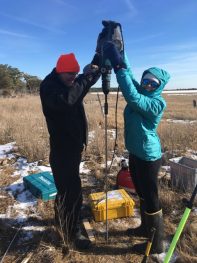
Project Title: Thin-layer sediment placement: evaluating an adaptation strategy to enhance coastal marsh resilience across the NERRS
Lead Investigator: Dr. Kenny Raposa, Research Coordinator, Narragansett Bay National Estuarine Reserve
WBNERR Project Contact: Dr. Megan Tyrrell
8 Reserves Included in Project: Great Bay NH, Waquoit Bay MA, Narragansett Bay RI, Chesapeake Bay MD, Chesapeake Bay VA, North Carolina, Grand Bay MS, Elkhorn Slough CA
Summary: Tidal marshes provide key ecosystem services, but are threatened by sea level rise. Narragansett Bay and Elkhorn Slough NERRs recently led a project to assess marsh resilience to sea level rise across 16 NERR sites, resulting in a scientific publication, user-friendly summary, and DIY tool. Currently, eight NERR sites across the East, Gulf and West coasts are actively testing strategies to examine the effectiveness of thin-layer sediment placement as a climate adaptation strategy.
Novel aspects of our project include the broad geographic scale, the examination of effectiveness at different marsh elevations, standardized monitoring, and the incorporation of biochar as a soil amendment to enhance carbon sequestration. Beneficial use of dredged sediment to enhance coastal resilience is a concept that resonates in many coastal states, and we have interviewed end-users from eight states interested in funding, permitting, implementation or monitoring of thin-layer sediment projects.
Investigating Salt Marshes as a source of Alkalinity and Low pH, High CO2 water to the Ocean
Project Title: Investigating Salt Marshes as a source of Alkalinity and Low pH, High CO2 water to the Ocean
Principal Investigators: Kevin Kroeger, Meagan Gonneea, U.S. Geological Survey: Woods Hole Coastal and Marine Science Center, Aleck Wang, WHOI
Funding Source(s): USGS, NSF
Examining decapod community composition and species interactions in salt marshes across New England
2016
Harriet Booth, Patrick Barrett, Meredith Burke, Dr. David Kimbro
Northeastern University
Funding Source(s): Northeastern University
Distinguishing denitrifying organisms across gradients
2016
Robinson W. Fulweiler(Boston University); Teri O’Meara (University of Auckland)
Funding Source(s): Boston University, University of Auckland
Relationship of phenotypic variation and genetic admixture in the Saltmarsh-Nelson’s sparrow hybrid zone
Project Title: Relationship of phenotypic variation and genetic admixture in the Saltmarsh-Nelson’s sparrow hybrid zone
Date: 2015
Principal Investigator(s): Walsh, Jennifer, et al.
Abstract: Hybridization is influential in shaping species’ dynamics and has many evolutionary and conservation implications. Identification of hybrid individuals typically relies on morphological data, but the assumption that hybrids express intermediate traits is not always valid, because of complex patterns of introgression and selection. Read full text…The Auk 132.3: 704-716. https://academic.oup.com/auk/article/132/3/704/5149087
The Great Sippewissett salt marsh plots—some history, highlights, and contrails from a long-term study
Project Title: The Great Sippewissett salt marsh plots—some history, highlights, and contrails from a long-term study
Date: 2015
Principal Investigator(s): Valiela, I.
Summary: During the 2013 meeting of the Coastal and Estuarine Research Federation, Iris Anderson, acting on behalf of the CERF Board, invited me to write an Odum Essay, describing the long stretch of work done in the Great Sippewissett Marsh in Cape Cod, MA, reviewing findings, and recalling how the sequence of results moved the efforts forward across over 40-plus years. Read full text…Estuaries and Coasts, 38(4), 1099-1120. https://link.springer.com/article/10.1007/s12237-015-9976-9
Preliminary evidence for the amplification of global warming in shallow, intertidal estuarine waters
Project Title: Preliminary evidence for the amplification of global warming in shallow, intertidal estuarine waters.
Date: 2015
Principal Investigator(s): Oczkowski, A., McKinney, R., Ayvazian, S., Hanson, A., Wigand, C., & Markham, E.
Abstract: Over the past 50 years, mean annual water temperature in northeastern U.S. estuaries has increased by approximately 1.2°C, with most of the warming recorded in the winter and early spring. A recent survey and synthesis of data from four locations in Southern Rhode Island has led us to hypothesize that this warming may be amplified in the shallow (<1 m), nearshore portions of these estuaries. Read full text… PloS one, 10(10), e0141529. http://journals.plos.org/plosone/article?id=10.1371/journal.pone.0141529
Quantifying the Impact of Low Oxygen Conditions on Sediment Methane Fluxes in Waquoit Bay
Lead Investigator: Wally Fulweiler, Boston University Marine Program
Funding Source: MIT-Seagrant
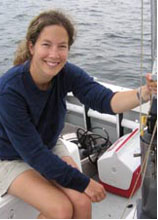 The negative consequences of excess nutrient loading alter estuarine sediment nutrient cycling in general and the production of methane in particular. On a per molecule basis, the impact of methane on climate is over 20 times greater than carbon dioxide (over a 100 year period). And even though estuaries make up a small portion of the total global ocean area they contribute about 10% of the total ocean methane emissions. Thus, quantifying how the production of methane in estuaries changes seasonally and spatially is an important step in our understanding of coastal systems and future climate. The purpose of this ongoing research is to quantify sediment methane production in Waquoit Bay, MA and to determine how low oxygen conditions alter these rates. To do this we collect sediment cores at four sites exposed to varying oxygen conditions in the Waquoit Bay system and measure methane fluxes across the sediment-water interface. Additionally, we will conduct experimental manipulations where we alter the oxygen conditions in the overlying water to see how this impacts methane fluxes. For more information please go to: www.fulweilerlab.com and follow us @Fulweilerlab.
The negative consequences of excess nutrient loading alter estuarine sediment nutrient cycling in general and the production of methane in particular. On a per molecule basis, the impact of methane on climate is over 20 times greater than carbon dioxide (over a 100 year period). And even though estuaries make up a small portion of the total global ocean area they contribute about 10% of the total ocean methane emissions. Thus, quantifying how the production of methane in estuaries changes seasonally and spatially is an important step in our understanding of coastal systems and future climate. The purpose of this ongoing research is to quantify sediment methane production in Waquoit Bay, MA and to determine how low oxygen conditions alter these rates. To do this we collect sediment cores at four sites exposed to varying oxygen conditions in the Waquoit Bay system and measure methane fluxes across the sediment-water interface. Additionally, we will conduct experimental manipulations where we alter the oxygen conditions in the overlying water to see how this impacts methane fluxes. For more information please go to: www.fulweilerlab.com and follow us @Fulweilerlab.
Effects of Ocean Acidification on the Food Location Behavior of the Marine Snail P. longicarpus
PIs: Ivan Valiela, MBL Ecosystems Center
Oliver Newman, WHOI Guest Student
Funding: WHOI, Mariot Foundation
Greenhouse Gas Sensing in Coastal and Salt Marsh Environments
Project Title: Greenhouse Gas Sensing in Coastal and Salt Marsh Environments
Date: 2012
Principal Investigators Anna Michel, Princeton University
Funding: WHOI and submitted grants (NSF, MIT Seagrant)
Comparing Methods and the Stability of Deep-Driven Rod Elevation Benchmarks and SETs in a Salt Marsh Environment
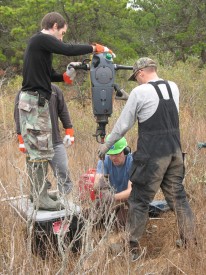 PIs: Philippe Hensel, National Geodetic Survey
PIs: Philippe Hensel, National Geodetic Survey
Galen Scott, National Geodetic Survey, University of RI
Jim Lynch, US Geological Survey
WBNERR Staff: Jim Rassman, Jordan Mora, Chris Weidman
Description: Sediment Elevation Tables (SETs) and benchmarks are used to measure change in marsh elevation with millimeter scale accuracy to determine sedimentation rates. This information, combined with accurate water level measures, can assess whether salt marshes are keeping up with sea level rise or risk being “drowned.” Traditionally SETs and benchmarks are installed by driving metal rods deep into the earth until they hit resistance. This can be difficult and costly as each 4’ length of rod is expensive. This project is investigating whether it is necessary to drive the rods that deep, or whether they are just as stable at, say, 20’ depth. Rods have been driven to different depths in the South Cape Beach salt marsh and are being “leveled” regularly – measured against a known point – to see if they have shifted. If not, this research could result in new standards for installation of this infrastructure which would save significant time and money. This is one of a growing number of projects in the new “Climate Change Observatory” in this marsh.
Development of an In-situ Automated pCO2 and Alkalinity Sensor Instrument – RATS
Project Title: Development of an In-situ Automated pCO2 and Alkalinity Sensor Instrument – RATS
Date: 2013
Principal Investigator(s): Dan McCorkle, WHOI, Bill Martin, WHOI, Fred Sayles, WHOI
Funding: WHOI Coastal Institute, collaborative in-kind WBNERR
Ocean / Estuarine Acidification – pCO2, pH and Aragonite Saturation State in Waquoit Bay and its Potential Impact on Shellfish
Project Title: Ocean / Estuarine Acidification – pCO2, pH and Aragonite Saturation State in Waquoit Bay and its Potential Impact on Shellfish
Date: 2013
Principal Investigator(s): Dan McCorkle, WHOI, Bill Martin, WHOI, Anne Cohen, WHOI
Funding: WHOI, collaborative in-kind WBNERR
The Impact of Nitrogen-loading on Salt Marsh Greenhouse Gas Fluxes
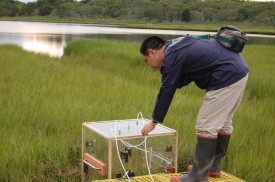 PIs: Serena Moseman-Valtierra, University of Rhode Island, Jianwu Tang, MBL Ecosystems Center, Kevin Kroeger, USGS-Woods Hole Science Center,
PIs: Serena Moseman-Valtierra, University of Rhode Island, Jianwu Tang, MBL Ecosystems Center, Kevin Kroeger, USGS-Woods Hole Science Center,
Funding: MIT Seagrant
The general goal for the project is to measure potential greenhouse gas (GHG) emissions and net CO2 uptake in coastal wetlands under a range of realistic nitrogen (N) loads and inundation (sea) levels. By meeting this goal, we aim to improve the information with which managers and policy makers can maintain and maximize ecosystem productivity, reduce harmful feedbacks of climate, and assess the potential for these ecosystems to enter C markets.
We will examine how GHG emissions from salt marshes vary along an existing gradient of anthropogenic N loading in Waquoit Bay, MA (WB-NERR). Further, we will test for relationships between N loads to the marshes and plant productivity. To investigate the influence of anticipated future increases in sea level, we will use existing gradients in marsh soil elevation (and therefore a gradient in soil water saturation and in frequency and duration of soil inundation) as a space-for-time substitution simulating future inundation of soils.
Carbon Management in Coastal Wetlands: Quantifying Carbon Storage and Greenhouse Gas Emissions by Tidal Wetlands to Support Development of a Greenhouse Gas Protocol and Economic Assessment
Project Title: Carbon Management in Coastal Wetlands: Quantifying Carbon Storage and Greenhouse Gas Emissions by Tidal Wetlands to Support Development of a Greenhouse Gas Protocol and Economic Assessment
Project Lead: Alison Leschen, Waquoit Bay Reserve Manager
Collaborative Lead: Tonna-Marie Rogers, Waquoit Bay Coastal Training Program Coordinator
Principal Investigator(s): Jianwu Tang, MBL Ecosystems Center, Kevin Kroeger, USGS-Woods Hole Science Center, Neil K. Ganju, USGS-Woods Hole Science Center, Serena Moseman-Valtierra, University of RI, Omar Abdul-Aziz, Florida International Univ., Stephen Emmett-Mattox, Restore America’s Estuaries, Igino Emmer, Silvestrum, Stephen Crooks, Consultant to RAE, Pat Megonigal, Smithsonian ERC, Thomas Walker, Manomet CCS, Chris Weidman, Waquoit Bay Reserve Research Coordinator,
Funding: NERRS Science Collaborative
Summary: Increasing atmospheric concentrations of three major greenhouse gases (GHG) are the main drivers of climate change. Efforts to ameliorate rising levels of GHG include the protection and restoration of ecosystems that constitute major carbon (C) sinks and minor sources of CH4 and N2O emissions. Tidal marshes are prime candidates for such efforts as their sediments display high C sequestration. Loss of wetlands through human impacts such as land conversion, sediment supply disruption, nutrient loading, and with sea level rise, reduces future sequestration capacity and places at risk stores of C that built up over past centuries. Improved management of coastal C and nitrogen (N), based upon sound science, is a critical first step towards mitigation of climate change and management of coastal ecosystems. Management must address N loading that has the dual impact of 1) contributing to climate change through production of N2O, and 2) reducing production of root and soil matter by plants which can decrease the C sequestration capacity and resilience of marshes to sea level rise. Recognition of the importance of coastal marine systems in terms of C storage has led to national and international efforts to place monetary value on preserving or restoring the “blue carbon” in those systems, analogous to the value placed on forests. The barrier to incorporation of tidal wetlands into C markets is the absence of agreed upon GHG offset protocols that set guidelines for monitoring and verification requirements for wetlands projects, and a lack of data and knowledge regarding C and GHG fluxes in wetlands to support model development.
The project goals are to provide scientific information that can inform both C and N management as well as wetlands protection and restoration strategies for supporting development of policy frameworks and market-based mechanisms to reduce GHG.
Project website: https://waquoitbayreserve.org/research-monitoring/salt-marsh-carbon-project/
Collaborative Research


